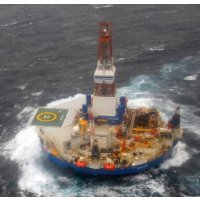Arctic Oil Rig Grounded Dangerously in Alaska
 Shell Oil Drilling Platform Kulluk (AP Photo)
Shell Oil Drilling Platform Kulluk (AP Photo)
State environmental and oil company officials have struggled for nearly a week to secure a mobile oil-drilling rig that broke loose last week off the coast of Alaska.
The Kulluk rig was being towed in stormy seas by a Shell-contracted icebreaking tug, the Aiviq, near the Coast of Sitkalidak Island when a towline failed on December 27. The Aiviq and a tugboat tried to secure the Kulluk before it grounded itself off the island, but failed and the grounding occurred Monday night. All 18 crew members had evacuated the Kulluk for safety reasons, so there was no one on the rig to maneuver equipment as part of the attempted recovery.
Alaska’s Department of Environmental Conservation has reported the rig carries 138,000 gallons of diesel fuel, as well as 1,000 gallons of aviation fuel and 12,000 gallons of lubricants, all of which could spill into the coastal waters if the Kulluk breaks up in the surf.
The $290 million, 266-foot-diameter Kulluk was being used to drill an exploratory oil well as part of Shell’s efforts to expand resource exploitation off Alaska.
The problems encountered by the Kulluk were not unexpected…at least to people other than those who work for Shell or the U.S. government. In August, when the Obama administration gave Shell the go-ahead for exploratory drilling, environmentalists warned that Shell and federal regulators were not prepared to deal with the dangers that come with oil drilling in frozen waters. Shell tested its oil well blowout prevention system during the summer. But according to records obtained by the watchdog group Public Employees for Environmental Responsibility (PEER), the testing was “cursory” and brief, lasting only two hours.
As of January 1, no fuel was seen leaking from the rig, according to the U.S. Coast Guard. The area off Sitkalidak Island is home to salmon, harbor seals and Steller's eiders, a sea duck considered an endangered species.
In response to the grounding, environmentalists have called for a review or even a halt of the controversial drilling program. Rick Steiner, a former professor with the University of Alaska who is now an environmental consultant through Oasis Earth, told the Anchorage Daily News that emergency towing resources were not in place before the accident.
“There is a lot to learn about this cascade of failures that put the Kulluk on the rocks,” Steiner said in an email to the newspaper. “Clearly Shell should have thought through contingencies for a loss of tow in heavy weather, and they didn't. The weather encountered is not extreme and unexpected in the Gulf of Alaska in the winter—it’s just winter. This doesn't inspire confidence in their safety and contingency planning capability.”
-Noel Brinkerhoff
To Learn More:
Shell Drilling Rig Grounds off Kodiak Island after Towlines Fail for 5th Time (by Lisa Demer, Anchorage Daily News)
Tow Lines attached to Shell Oil Drilling Vessel in Gulf of Alaska (by Lisa Demer, Anchorage Daily News)
Shell Safety Testing for Arctic Drilling Blowout Lasted for Only 2 Hours (by Noel Brinkerhoff, AllGov)
Obama Gives Green Light to Shell Drilling for Oil in Arctic (by Noel Brinkerhoff, AllGov)
Obama Moves Closer to Allowing Shell to Drill in Arctic (by Noel Brinkerhoff and David Wallechinsky, AllGov)
- Top Stories
- Unusual News
- Where is the Money Going?
- Controversies
- U.S. and the World
- Appointments and Resignations
- Latest News
- Trump to Stop Deportations If…
- Trump Denounces World Series
- What If China Invaded the United States?
- Donald Trump Has a Mental Health Problem and It Has a Name
- Trump Goes on Renaming Frenzy






Comments